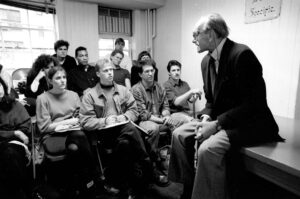

Useful Links
Contact
- The Bridge at Cecil Sharp House
- 2 Regent’s Park Rd, London NW1 7AY
- 020 7424 0860
- admin@thebridge-ttc.org
Social Media


Let’s go back to basics and remind ourselves what screen acting actually is. When acting for screen you give an acting performance that is filmed so the audience can watch later on tv, film, or devices. This sets it apart from other forms of acting, such as live stage acting or radio acting. Either way, it’s an acting role like any other and involves many of the same tasks, but there are differences and pitfalls that you should be aware of if you want to be the best screen actor you can be.
Be prepared
For any acting performance, being sufficiently prepared should go without saying. This means learning your lines, turning up to the shoot on time, wearing the right clothing, and reading the whole script beforehand from start to finish – not just your own lines. Unless you’re recording a self-tape, you’ll be working with a team of people who are relying on you to deliver – and being unprepared may discourage them from working with you again. Make sure you show you’re a reliable and professional actor.
Be the character
This applies to every acting role but many actors take it for granted. For the duration of your performance, you’re not an actor delivering lines and following blocking, you’re the character you’re portraying, which means taking their actions and reacting to their situation. This goes double for screen acting as you’re much more exposed than stage acting where the audience is far away in their seats. When acting for the screen, the audience is where the camera is and often that camera is right up in your face zoomed in. People will be able to pick on every facial movement and expression so don’t skip a beat – make sure everything you’re doing is the character and not you. When preparing the role, think about what motivates your character to do and say the things they do. How would they react to the words and actions of other characters in the scene? Make sure to actively listen to others delivering their lines as your character would.
Don’t over-emote
Truly being the character you’re playing will make for as natural a performance as possible for the camera to film. But, deliberately putting in too much emotion will make it feel unnatural. The audience can pick up on it – especially if an actor’s face is up close on the screen. Look at the scene from your character’s perspective and take an action that leads to the character’s true emotional response. This will be compounded by the Kuleshov Effect where the audience is able to recognise emotions based on context rather than something the actor is doing with their face. For instance, if a character has just received some sad news during the previous shot, we’ll assume the actor is feeling sadness, even if they’re just displaying a neutral expression. There will be absolutely no need for the actor to ham it up and try extra hard to convey the emotion that’s already been communicated to the audience.
Be mindful of camera coverage
All the different camera shots in a scene are known as camera coverage and this is something that you should take into account when acting for screen. Shots from different angles and distances have the following terms:
Help things to run smoothly by learning the jargon. Most importantly ensure that what you’re doing is consistent in each take so your performance has continuity. For instance, if it’s one camera recording shots from different angles, you need to make it looks like it was one performance being recorded by multiple cameras simultaneously. Also, if the director gives you notes or wants some aspect of your performance to be different, then you’ll need to keep that new change for all the various shots. You don’t want to break the illusion by having the audience notice continuity errors.
Make the editor’s job easier
When acting for screen, your performance will only get seen by the audience once the editor has pieced the takes together into a publishable form. Make friends with the editor and they’ll make you look as good as they can. Leave room at the start and end of the scene for the editor to play with when making transitions or fade ins/outs. Don’t suddenly break character as soon as the lines have been read and the scene’s over. Also don’t move around too much during close ups and avoid looking at the camera, unless you’re supposed to.
When performing live on stage you have to get everything right the first time. There’s no option to retake or tidy things up in post-production. Because of these pressures there is extensive rehearsal required for theatre acting, to give the audience the same great show each time. There is also a greater need to project your voice more on stage in order for the audience all the way at the back of the theatre to hear you clearly – which can require extensive voice training. It’s common for actors to get stage acting experience first and transfer those skills over to screen. The list of great actors who started their careers on stage, but crossed over into screen, is endless.
While screen acting may not have the same immediate pressures as live stage acting, it is still its own nuanced and skilled medium in its own right. It takes time and practice to develop, just like any other skill. One of the hardest parts of acting for screen is adjusting to the technical aspects, like hitting marks, maintaining continuity across multiple takes, and conveying emotions in close-up shots where every subtle expression matters. Additionally, maintaining authenticity and believability while performing in front of a camera, often without immediate feedback from a live audience, can be challenging for some actors.
The best way to get into screen acting is through training and building experience. Take an acting course that will help you hone your screen acting skills. You can also attend workshops and classes or work on video projects with friends for social media. You can check out our advice here on how to become an actor as much of this will apply to screen acting, too. You should also think about your end goal for screen acting – is it something you want a career in or do you see it as more of a hobby? If you’re serious about starting a screen acting career, then it’s highly recommended to get proper training to bring you up to speed on everything you need to know.
In a digital world, it’s more important than ever for actors to know what they’re doing when in front of a camera – which is why screen acting is a vital part of our acting courses here at The Bridge.
When you train with us you’ll receive personalised tuition for screen acting and a professional acting showreel which will be recorded and produced for you. This showreel will be essential for showcasing your talents to industry personnel looking to cast roles. With our screen acting training, we’ll make sure your new showreel shows you off at the top of your screen acting game.

